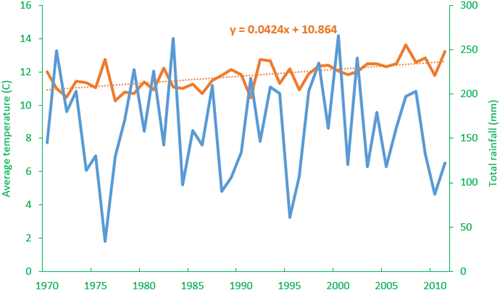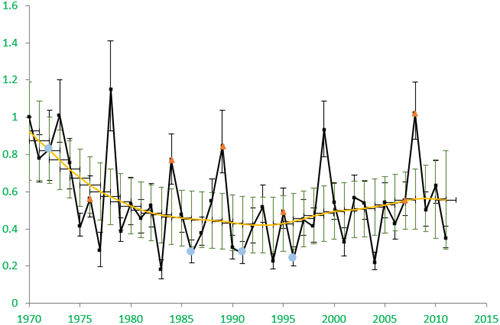Over 40 years of data on invertebrate abundance in cereals, cropping patterns, pesticide use and weather in the Sussex Study area gave us the opportunity to investigate how invertebrate abundance changed in relation to changes in farming and climate. We used information from a national dataset of weather variables provided by the Meteorological Office to look at the long-term trends in weather (average April, May and June temperature and total rainfall) and identify extreme weather events (particularly high or low temperature and precipitation) that may have affected the invertebrates in cereal fields across the Sussex Study area. Both long-term changes in weather and an increased frequency of extreme weather events are predicted under current IPCC climate change models.

Fig 1: Long-term changes in spring (April-June) temperature (orange) and rainfall (blue)
on the Sussex Study area from 1970 to 2011, from a national dataset (Perry & Hollis
2005). The average daily temperature during the study period has risen by 1.7˚C.
We identified 12 extreme weather events since 1970, giving us 10 years that could be classified as cold and wet (1972, 1986, 1991, 1996) or hot and dry (1976, 1984, 1989, 1995, 2007, 2008). These were compared with year-to-year changes in the abundance of 26 invertebrate groups identified in the Sussex Study dataset, 11 of which were found to be sensitive to these extreme events.

Fig 2: Annual index of change in spider (Araneae) abundance in the Sussex Study from
1970 to 2011. Cold/wet years are indicated with blue dots, hot/dry years with orange
triangles. Spider abundance increased in hot years and decreased in cold years.
Numbers of most invertebrates recovered to their former levels within a year. This suggests that the perturbation cycle of farmed environments (the cereal habitat is one that lasts for less than a year in most cases) favours adaptable species that are able to cope with variable weather conditions.
Some of the long-term trends in invertebrate abundance were correlated with temperature and rainfall, suggesting that these factors may have an effect. The effect varied between taxa but mostly increased with temperature rises and fell with increased rainfall. Springtails (Collembola), which thrive in moist soil, were an exception to this pattern.
In addition to weather, we considered the effect on invertebrate abundance of pesticide use, which has increased throughout the study period. Overall, the effect was mainly negative. Comparing the relative effect of weather and pesticide use, the abundance of invertebrates of interest in terms of Integrated Pest Management (IPM) – those that feed on insect pests – were affected more by pesticide use than by weather. Declines in their abundance were related to increases in pesticide use. On the other hand, weather affected the abundance of invertebrates that feed on plants (some of which are cereal pests) or rotting plant material, with increases in abundance as temperature increased.
Climate change, in the long term, is likely to cause changes in certain groups of organisms, some of which will be cereal pests, whose abundance may increase. Therefore, one of the consequences of climate change may be increased use of pesticides in response to pest outbreaks. An increased use of pesticides will negatively affect the abundance of all invertebrate groups, many of which are beneficial, like the predatory invertebrates that provide natural pest control and those eaten by farmland birds.
This could be mitigated through a shift in emphasis from pesticides as a means to control invertebrate pests to the use of conservation headlands alongside beetle banks as part of an agri-environment scheme that enhances IPM as well as food resources for declining farmland birds.
Acknowledgements
Collection of Sussex Study data was funded internally by the GWCT; the analysis was supported by Natural England.
Further reading
- Ewald, J. A., Wheatley, C. J., Aebischer, N. J., Moreby, S. J., Duffield, S. J., Crick, H. Q. P. and Morecroft, M. B. (2015), Influences of extreme weather, climate and pesticide use on invertebrates in cereal fields over 42 years. Global Change Biology, 21: 3931-3950.
- Ewald, J.A. & Aebischer, N.J. 2000. Trends in pesticide use and efficacy during 26 years of changing agriculture in southern England. Environmental Monitoring and Assessment, 64: 493-529.
- Potts, G.R. 2012. Partridges: Countryside Barometer. New Naturalist Library Book 121. Collins, London.
- Ewald, J.A., Wheatley, C.J., Aebischer, N.J, Duffield, S., Morecroft, M. & Crick, H.P.Q 2014. Cereal invertebrates, extreme events and long-term trends in climate. Natural England Commissioned Report NECR135.